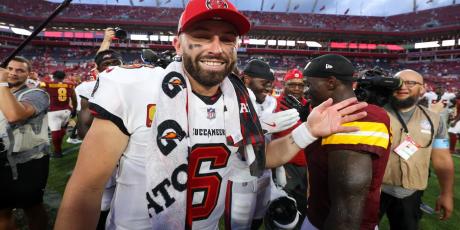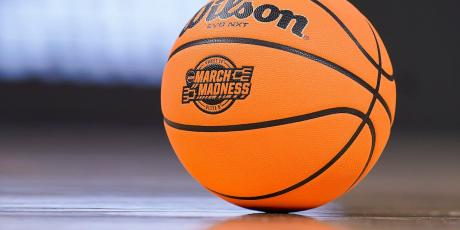How Did the NFL Draft Impact Rookie MFL10 ADP?

Now that the NFL draft is over and we know where all the rookies have landed, it's time to dive into how and where you should draft them. Most rookie ADPs are still changing, and will continue to change, throughout the summer as different people join MFL10 leagues and we get away from the dynasty draft season. In past years we saw rookies get a large jump right after the draft but then slowly tick back down the ranks. If you are in a lot of drafts, it's best practice to grab rookies as their ADPs climb, lay off as ADPs peak, and begin drafting again as ADPs begin to drop. Throughout this time, if you think a particular rookie is overvalued, avoid him altogether, and if you think someone is undervalued, draft away.
You can find a full list of MFL10 ADPs and their dynamic changes over the last two week and four week period HERE.
Quarterbacks
Taking a rookie quarterback in any sort of redraft league is generally not the best idea, and this year is no different. Even though last year Jameis Winston (ADP of QB20) and Marcus Mariota (ADP of QB23) met or exceeded value (Winston finished as the QB14 and Mariota as QB22), they are not the norm. This year the only sure fire starter is Jared Goff, who is headed to an ugly Rams situation, and just because the Rams have changed cities it doesn’t mean that their offense has changed.
| Player | Team | Pre-Draft ADP | Post-Draft ADP |
|---|---|---|---|
| Jared Goff | LA | 19.07 | 19.04 |
Goff is going off as the QB31. Given that there are 32 teams, his ADP tells you all you need to know. If he is going to be a third QB on your roster, you may be better off just take a third defense or a RB/WR flyer. The best case scenario is that he cracks your starting lineup a few weeks, netting you just a handful of points. I’d rather take a flyer with Colin Kaepernick or Robert Griffin who can at least put up yards and touchdowns on the ground.
Runnings Backs
This year’s draft was very interesting for some top rated running backs, vaulting Ezekiel Elliott into the first/early second round of MFL10s, hurting Derrick Henry’s opportunity, and bumping up a bunch of late round guys.
| Player | Team | Pre-Draft ADP | Post-Draft ADP |
|---|---|---|---|
| Ezekiel Elliott | DAL | 3.07 | 2.04 |
| Derrick Henry | TEN | 6.11 | 7.11 |
| Kenneth Dixon | BAL | 12.12 | 10.01 |
| Devontae Booker | DEN | 15.03 | 12.07 |
| C.J. Prosise | SEA | 15.12 | 13.03 |
| Jordan Howard | CHI | 17.04 | 15.07 |
| Paul Perkins | NYG | 17.10 | 15.09 |
| Kenyan Drake | MIA | 17.12 | 17.01 |
| Alex Collins | SEA | 17.01 | 17.06 |
| Keith Marshall | WAS | 17.04 | 18.06 |
If you drafted Ezekiel Elliott in the third round or later before the NFL draft, enjoy those shares, as you won’t get him there again. While his ADP is still early second round, more times than not I have seen him go in the first, with a range from a top three pick to the early second round. If you want him, you may have to spend a first round pick on him, and he could very easily be worth it. Elliott’s ceiling is not just a RB1, but THE RB1, with a floor of a low end RB1 behind that Cowboys offensive line.
Derrick Henry joins newly signed DeMarco Murray in the Tennessee backfield. Henry was going around the six/seven turn before the NFL Draft, but is now going around the seven/eight turn. Henry could sit behind Murray most of the year, he could be in a time-share with Murray, or he could flat out push Murray aside. I think Henry’s ADP will drop for a little longer before settling in the late eighth or possibly the ninth round. Even there, he seems like a lot of risk for a player that could have limited opportunities in his rookie campaign.
A few of my favorite backs that saw big jumps in ADP are Kenneth Dixon (BAL), C.J. Prosise (SEA), Jordan Howard (CHI), and Paul Perkins (NYG). Both Dixon and Perkins go into crowded backfields with mediocre competition, giving them a fair chance to see a good amount of touches. Best ball formats really help talented backs in crowded backfields hit their value. Prosise and Howard join backfields that have unproven backs in Thomas Rawls and Jeremy Langford, giving the rookies a chance to earn playing time and hit some MFL10 value. Prosise is going in the early 13th round, which seems like fair value, and I love Howard and Perkins in the 15th round or later.
I do not understand how Devontae Booker jumped from the 15th to the 12th round after landing in a Denver backfield with C.J. Anderson. Based on opportunity, and compared to other rookies in similar situations, Booker should be going in the 13th at the very earliest.
As with any year, I will be taking some of these guys as flyers but will be not be heavily invested in any one rookie back.
Wide Receivers
Just like running backs, we saw a bunch of players shoot up the ADP ranks based on their new opportunity. The three biggest jumps were Corey Coleman, Sterling Shepard, and Michael Thomas landing with the Cleveland Browns, New York Giants, and the New Orleans Saints respectively.
| Player | Team | Pre-Draft ADP | Post-Draft ADP |
|---|---|---|---|
| Laquon Treadwell | MIN | 8.08 | 8.05 |
| Corey Coleman | CLE | 11.10 | 8.12 |
| Josh Doctson | WAS | 10.05 | 10.02 |
| Sterling Shepard | NYG | 16.09 | 12.06 |
| Michael Thomas | NO | 17.01 | 14.04 |
| Will Fuller | HOU | 17.04 | 15.01 |
| Tyler Boyd | CIN | 16.10 | 15.07 |
| Leonte Carroo | MIA | 18.08 | 17.09 |
The highest drafted WR before the draft, Laquon Treadwell, was being drafted in the middle of the eighth round and has remained at essentially the same ADP. Treadwell doesn’t seem like as much of a value when compared to many other rookie WRs after landing in a low octane passing offense in Minnesota. Coleman landed in a similar situation to Treadwell but with potentially less competition for targets, so his three round increase, which put him on par with Treadwell, makes sense.
Shepard and Thomas look like the biggest values at the moment, but expect their ADP to keep climbing for a while. I can see them both going in the 11th round or earlier very routinely given their landing spots on solid teams.
Another WR that didn’t gain much value was Josh Doctson, who remains an early to mid 10th round pick. Given his lack of a clear path to a starting spot in Washington, a 10th round pick seems very high. Unless either Pierre Garcon or DeSean Jackson get cut (which I don’t think is likely), Doctson will be blocked from solid playing time in his first year. I will be avoiding Doctson until he drops to round 15 or later, if he ever falls that far.
Tight Ends
This section is going to be quick. If you want to draft a rookie tight end, Austin Hooper (ATL) going at TE26 around the 15/16 turn is your only option. I may take just a few shares of him if he falls super late and need a third tight end, but as John Paulsen keeps saying, just don’t draft rookie tight ends, and be careful with sophomores at the position, as well. Hunter Henry (SD) will likely be stuck behind Antonio Gates this year.
Conclusion
The path to early playing time is key for rookies, unless you think that they are so talented that they can ascend the depth chart and put up league winning stats later in the season. Every rookie has a good amount of risk and for each situation, you must ask the following questions: How quickly can they learn a new system? Can the running backs learn pass blocking techniques? Will they get enough playing time? No matter how fitting the situation, every rookie has a non-zero chance to flat out bust. Take each rookie (even Elliot) with caution to minimize the risk of your overall MFL10 portfolio.
Editor's Note: Early bird rates for our 2016 subscription packages are available NOW! Sign up HERE!




















